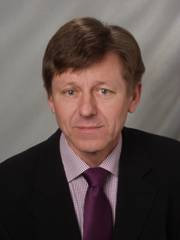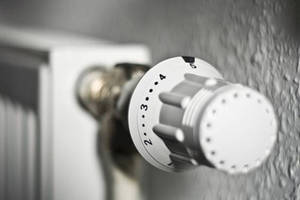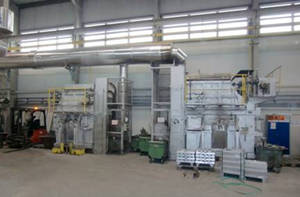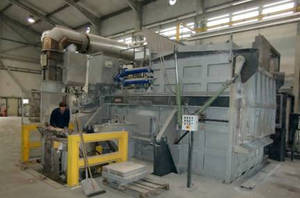 The smelting furnaces are connected to heat exchangers using a custom construction made by ZPF therm. The design engineers reacted to our requirements with a positive, 'can-do' manner", says Konrad Schmittlein, operational manager at JURA-GUSS. Source: JURA-GUSS GmbH |
Whether by solar thermal systems or heat pumps - in heating engineering, any way of supplying cheap energy is welcome. Until now, relatively little attention had been paid to the many sources of heat available in industrial plants. In particular, hundreds of kilowatt-hours of heating energy are lost every day in the exhaust gases emitted from smelting works and foundries. But now, the JURA-GUSS aluminium foundry has taken the step of connecting its melting furnaces to a system of heat exchangers, which then not only feed the space heating systems within the plant but also heat up the water used for cleaning the castings. The furnaces themselves are designed to be efficient with resources, which means that they are also well-insulated, to maximise the amount of melting heat available. Moreover, the furnaces, which are produced by melting furnace manufacturers ZPF therm, produce very little exhaust gas, thus allowing the foundry not only to save energy, but also to protect the atmosphere by reducing CO2.
JURA-GUSS GmbH in the Bavarian town of Beilngries produces around 300,000 castings per year for manufacturers for both small and large vehicles, international mechanical engineering companies and medical engineering firms. In all of these fields, environmental protection is of major importance. For instance, dust produced during by sand casting is removed by a suction system and the spent moulding sand subjected to a complex reconditioning process. Moreover, the company only uses rainwater from its own cistern. Not only that, but all castings are washed with water-based solvents, which circulate in a closed system. Clearly, the next logical step was to maximise the efficiency of its melting furnaces in compliance with low energy and resource consumption requirements.
Special exhaust gas flues reduce furnace pollutants
 Heating using exhaust process heat is on the increase: we are meanwhile receiving more and more enquiries for waste heat recovery techniques, says Leonhard Gutsche, design engineer at smelting furnace manufacturers, ZPF therm, which already implements exhaust heat recovery. Source: Henrik-Gerold Vogel, pixelio.de |
 The exhaust gas systems from the four smelting furnaces at JURA-GUSS are connected to heat exchangers by means of bypasses. These transfer the heat from the smelting process to the circulating water. Source: JURA-GUSS GmbH |
 The biggest furnace is sunk into the floor, which also makes it easier to clean. To empty the melt, the furnace is tipped into a cavity in the floor. Source: JURA-GUSS GmbH |
Since 1994, JURA-GUSS has been using melting furnaces manufactured by ZPF therm GmbH from Baden-Württemberg. Recently, the company installed its biggest furnace so far, comprising a system with a melting rate of three tonnes per hour and a holding capacity of ten tonnes, originally an exhibit from the GIFA 2007. "For us, a decisive factor was that fact that this furnace's consumption when holding was 100-120kWh of gas, which is very low," explains Konrad Schmittlein, operational manager at JURA-GUSS. "And not only that, the systems already comply with air quality regulations (TA Luft), so it is not necessary to install any additional exhaust gas cleaning systems."
All of these benefits are down to the special construction of the combustion chamber: the gases that form during the smelting process are not released directly through the chimney, in accordance with the principle of reverse air flow, but remain inside the furnace. This causes pollutants to be combusted, resulting in a very low dust particle content of less than three milligrams per cubic metre and a hydrogen fluoride content of only 0.4 milligrams. Another advantage of the technique is that heat from the exhaust gases can be used for heating the holding bath, which reduces both fuel consumption and CO2 emissions.
Exhaust fumes supply energy for heat exchangers
The flexible attitude shown by the furnace makers was central to the success of JURA-GUSS's objectives. More than just performing their standard functions, the goal was to recycle energy from the furnaces to serve the company's service water heating requirements. "In this respect, the design engineers reacted to our requirements with a positive, 'can-do' manner," says Schmittlein. Special connecting pieces were built into the furnace's exhaust gas systems, through which to divert the hot air. "If the outlet is connected to a chimney, the exhaust gases flow through this bypass to a heat exchanger, which transfers the process heat to the circulating service water," explains Leonhard Gutsche, design engineer at ZPF therm.
Altogether two heat exchangers, one for the large melting furnace and one for three smaller systems are in use; these heat up a 30,000-litre reservoir, the water from which supplies 80% of the production building with heat. It also heats the company's washing system for finished castings. The large furnace alone has two 1,000kW burners. After melting, as much as 35-40 percent of their heating energy flows to the heat exchanger, which converts around 75 percent of it into usable heat. The heat produced means additional heating is only required at weekends or any other times when little exhaust heat is available; two gas boilers of 400 and 200 kW are used for this purpose.
Lower-standing furnace now easier to clean
Another advantage of the new furnace is that a higher melting rate has been achieved without requiring an increase in personnel. This is in part due to the feeding mechanism of the system, which charges each batch in a single step, without the ingots needing repositioning. The main advantage, though, is that the furnace is now considerably easier to clean: as the new smelting furnace now stands 70cm lower in the ground, it can be cleaned quite easily from both sides, without any pedestals or other aids. All areas of the furnace are accessible through the large cleaning openings. To empty the melt, the furnace is tipped into a cavity in the floor, and the transport ladle is then transported upwards by a hydraulic mechanism.
This solution is one of the standard options available from ZPF therm. The connection system, however, was developed especially for JURA-GUSS. "We are meanwhile receiving more and more enquiries for waste heat recovery techniques. We are currently working on several projects in this area," says design engineer, Leonhard Gutsche.

